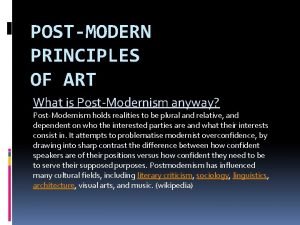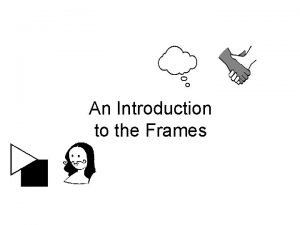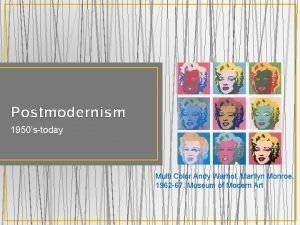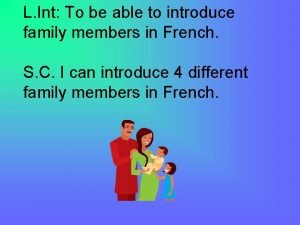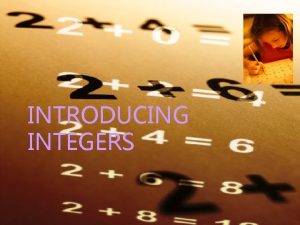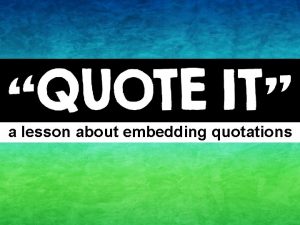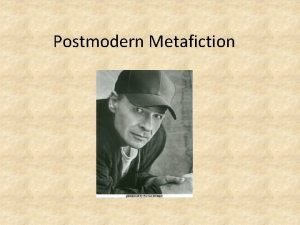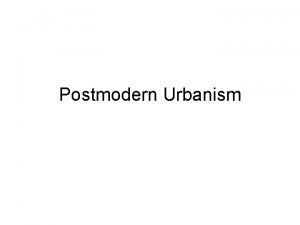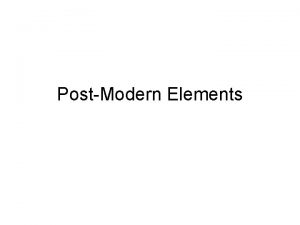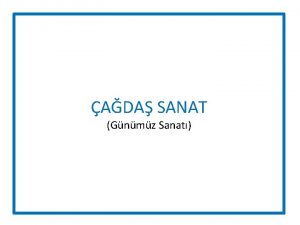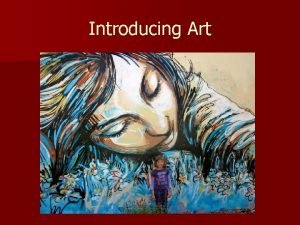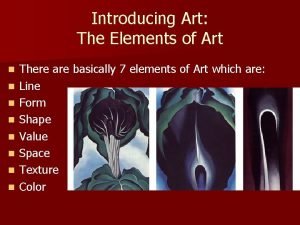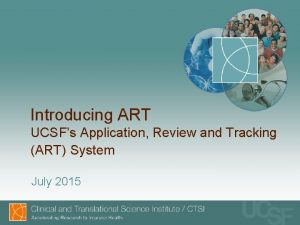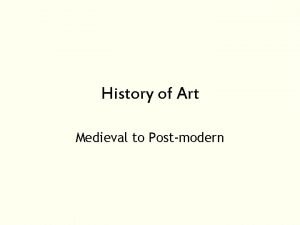Introducing The Postmodern Principles of Art The Postmodern





















- Slides: 21

Introducing. . The Postmodern Principles of Art

The Postmodern Principles of Art • Appropriation • Gazing • Hybridity • Interaction of Text and Image • Juxtaposition • Layering • • Recontextualization Identity/ Representing

Appropriation – the removal of images or material from one context and its reuse in another very different context. A recycling of images, so to speak. Appropriation usually raises ideas about originality or authorship (plagiarism), or exposes some unrecognized irony in the original. Sampling and excavation refer to similar type of borrowing practices used in creating music. Question of artist’s copyright are often a concern. Artist: Meryl Smith http: //merylsmith. blogspot. com/

Appropriation---What has the artist appropriated or borrowed? How has the artist changed the subjects’ meaning?

Appropriation What sentiment do the below pictures convey?

Gazing – This is more than just mere seeing or looking with intent. The “gaze” is frequently used to recognize that when talking about the act of looking it is important to consider who is being looked at and who is doing the looking. Gazing is concerned with social issues of knowledge, pleasure, and power, and of controlling perceptions about what is “real” and “natural. ”

Gazing In Betye Saar’s The Liberation of Aunt Jemima, the traditional meaning of the saccharine image is challenged when it is paired with an even more stereotypical depiction of a wide-eyed, red lipped African. American woman (holding a broom in one hand a rifle in the other) and with a Black Power clenched fist.

GAZING---“James Elkins offers ten different ways of looking at a figurative painting in a gallery (Elkins 1996, 38 -9): 1. You, looking at the painting, 2. figures in the painting who look out at you, 3. figures in the painting who look at one another, and 4. figures in the painting who look at objects or stare off into space or have their eyes closed. In addition there is often 5. the museum guard, who may be looking at the back of your head, and 6. the other people in the gallery, who may be looking at you or at the painting. There are imaginary observers, too: 7. the artist, who was once looking at this painting, 8. the models for the figures in the painting, who may once have seen themselves there, and 9. all the other people who have seen the painting - the buyers, the museum officials, and so forth. And finally, there also 10. people who have never seen the painting: they may know it only from reproductions. . . or from descriptions. ”

Hybridity – This refers to a combination or mixing of media in many contemporary art works, i. e. video projections in a sculptural installation. The concept of hybridity also describes the cultural blending that is evident in many recent works.

Hybridity Combinations of still image, moving image, sound, digital media, and found objects. Dieter Roth Tonbild (Sound Picture) 1975 -1988 oil, plexiglass, cassette players, wood; Polaroid photograph, ink on paper overall installed 78. 75 x 40. 375 x inches T. B. Walker Acquisition Fund, 1995 Copyright retained by the artist

Interaction of Text and Image – Barbara Kruger http: //www. eng. fju. edu. tw/Literary_Criticism/feminism/kruger. htm Interaction of Text and Image – An action that creates a deliberate disjunction between the meanings of an image and text when they are combined. The text does not describe the image, nor does the image illustrate the text, but their juxtaposition can generate new meanings through association.

Juxtaposition – the seemingly random placement or situating of images or objects in an art work. By juxtaposing images, artists intend that this clash causes a reaction of shock or surprise in the

Juxtaposition http: //www. tate. org. uk/search/peter%20 ken nard Object Meret Oppenheim (Swiss, 1913– 1985) Peter Kennard

Juxtaposition Banksy

Layering – a strategy of piling images on top of one another to mirror the complexity of the world and the unconscious mind. Multiple transparent layers can evoke ideas of simultaneity, coincidence, and ambiguity.

http: //www. fineartblog. co. uk/? m=201007 Crush II’ by Louise Dear Layering

Recontextualization – the placement of a familiar image in relation to pictures, symbols, texts, or situations with which it is not usually associated, in order to create new meanings.

Recontextualization Hannah Hoch, one of the early Dada proponents of the new medium of photomontage created many provocative works by recombining found imagery. In Die Braut of 1927, winged objects swirl around the central image of a traditional bride and groom. The woman’s head is replaced by the oversized image of a young child’s face (Makela & Boswell, 1996). This simple visual move changes any potential romantic fantasy reading of the bridal couple, shifting focus to society’s degrading legal, religious, and cultural conventions regarding the status of women.

Identity (Representing) Shirin Neshat • the strategy of locating one’s artistic voice within one’s personal history and culture of origin. • Her work refers to the social, cultural and religious codes of Muslim societies and the complexity of certain oppositions, such as man and woman.

Identity (Representing) Shirin Neshat • A common theme is that she uses sacred or well-known Iranian text written in beautiful calligraphy and paints them directly onto her subjects, in way saying what the women cannot say. Her photos are all about giving s voice to the women of Iran.

Identity (Representing) Shirin Neshat • • Neshat uses guns into a lot of her photos because she wishes to symbolize the violence in the lives of Iranian women and the pain that it causes them and their families. Traditionally in Iran it is forbidden to bear the bottom of your feet, so writing calligraphy on exposed feet is controversial.
 Post modern principles
Post modern principles Postmodern principles of art
Postmodern principles of art Elements and principles of hybridity
Elements and principles of hybridity Subjective frame artworks
Subjective frame artworks Andy warhol postmodernism
Andy warhol postmodernism Post modern frame
Post modern frame Good signal phrases for quotes
Good signal phrases for quotes Rowe concise introduction to linguistics download
Rowe concise introduction to linguistics download Introducing james joyce
Introducing james joyce Quote explanation sentence starters
Quote explanation sentence starters What is a counterclaim in writing
What is a counterclaim in writing Introduce yourself sample
Introduce yourself sample Talk boost tracker
Talk boost tracker Ma
Ma Riddle poem
Riddle poem Introduction to digestive system
Introduction to digestive system What type of company is kfc
What type of company is kfc Opposite numbers definition
Opposite numbers definition Mpls internet access
Mpls internet access Mla format quotes
Mla format quotes New market offering
New market offering As he himself puts it the art of quoting summary
As he himself puts it the art of quoting summary
